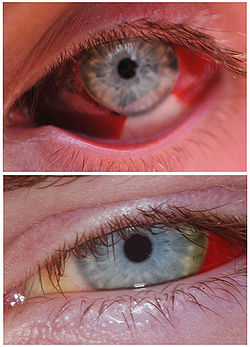Subconjunctival bleeding
| Subconjunctival bleeding | |
|---|---|
| Specialty | Ophthalmology |

A subconjunctival hemorrhage (or subconjunctival haemorrhage) also known as hyposphagma, is bleeding underneath the conjunctiva. The conjunctiva contains many small, fragile blood vessels that are easily ruptured or broken. When this happens, blood leaks into the space between the conjunctiva and sclera.
Whereas a bruise typically appears black or blue underneath the skin, a subconjunctival hemorrhage initially appears bright-red underneath the transparent conjunctiva. Later, the hemorrhage may spread and become green or yellow, like a bruise. Usually this disappears within 2 weeks.[1]
Although its appearance may be alarming, in general a subconjunctival hemorrhage is a painless and harmless condition; however, it may be associated with high blood pressure, trauma to the eye, or a base of skull fracture if there is no posterior border of the hemorrhage visible.

Causes
- Blood dyscrasia
- Blood thinners
- Diving accidents - Mask squeeze (volume inside in mask creates increased pressure with increased depth)
- Severe hypertension
- LASIK
- Leptospirosis
- Eye trauma
- Increased venous pressure
Subconjunctival hemorrhages in infants may be associated with scurvy (a vitamin C deficiency),[2][3] abuse or traumatic asphyxia syndrome.[4]
Management
A subconjunctival hemorrhage is typically a self-limiting condition that requires no treatment in the absence of infection or significant trauma. The elective use of aspirin and NSAIDs is typically discouraged. Artificial tears may be applied.[5]
References
- ^ Robert H. Grahamn (February 2009). "Subconjunctival Hemorrhage". emedicine.com. Retrieved 23 November 2010.
- ^ "Möller-Barlow disease". whonamedit.com. Retrieved 23 November 2010.
- ^ Bruce M. Rothschild (December 17, 2008). "Scurvy". eMedicine.com. Retrieved 23 November 2010.
- ^ Spitzer S. G, Luorno J., Noël L. P. "Isolated subconjunctival hemorrhages in nonaccidental trauma". ncbi.nlm.nih.gov. Retrieved 23 November 2010.
{{cite web}}: CS1 maint: multiple names: authors list (link) - ^ Robert H. Grahamn (February 2009). "Subconjunctival Hemorrhage". emedicine.com. Retrieved 23 November 2010.
